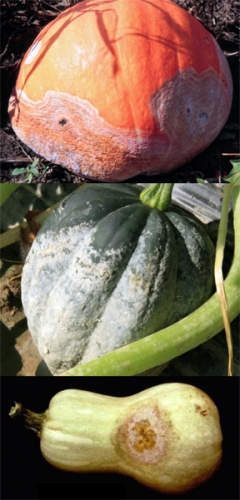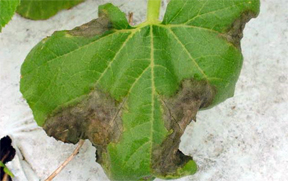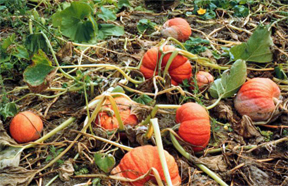Managing Phytophthora on winter squash
Editor’s note: This article is from the archives of the MSU Crop Advisory Team Alerts. Check the label of any pesticide referenced to ensure your use is included.
Michigan producers are experiencing significant losses in hard squash from Phytophthora capsici. The most obvious symptoms on the fruits are white spores that look similar to powdered sugar on the fruit surface. Eventually, the infected fruits will rot. It is possible to harvest fruits that look healthy, but symptoms of Phytophthora appear days later while the crop is in transit or on grocers’ shelves. Symptoms on the roots and crowns include browning of tissue and rot, and lesions may appear on the foliage.
The best way to avoid Phytophthora in a field is to take preventive measures before there is an outbreak. If there is a history of Phytophthora in a field, do not plant susceptible crops in the future.
Water management is an important component of managing Phytophthora. Because the disease can spread through water, it is essential that fields be well-drained and that low-lying areas of the field be left unplanted. Overhead irrigation should be sparse and drip irrigation is recommended. Irrigation water should not be drawn from surface water sources as it may be infested with Phytophthora spores.
If Phytophthora is recognized in the field, remove the diseased plants and the surrounding, healthy-looking border plants. Make sure to clean any equipment used in the field to prevent spread to other areas, and discard the infected fruit in an area where crops are not grown. Hard squash and pumpkins can also be planted into raised beds, which allows for excess water to move away from the susceptible root and crown area.
For most crops, applying fungicides early and often is recommended. Many hard squash and pumpkin plants produce large, dense canopies and proper application equipment is often required to achieve adequate protection of the fruits. Air-assisted nozzles will push the fungicide through the canopy more effectively than conventional nozzles. Several fungicides are registered for use on hard squash and pumpkin. In Michigan, some Phytophthora is insensitive to the fungicide mefenoxam (Ridomil Gold, Ultra Flourish). Mefenoxam is no longer effective in these regions.
Fumigants Telone C35, Sectagon-K54, Sectagon 42, and Vapam HL are registered for use on winter squash and pumpkin to control Phytophthora. Please consult the accompanying fumigation article for further information.
If you do not have a history of Phytophthora in your fields, do everything you can to prevent it from occurring. Scout often for disease, rotate only with nonsusceptible crop hosts, and irrigate conservatively from a well. Rotate fungicides in order to prevent the pathogen from becoming resistant.
Remember that the pesticide label is the legal document on pesticide use. Read the label and follow all instructions closely. The use of a pesticide in a manner not consistent with the label can lead to the injury of crops, humans, animals, and the environment, and can also lead to civil or criminal fines or condemnation of the crop. Pesticides are good management tools for the control of pests on crops, but only when they are used in a safe, effective and prudent manner according to the label.
Recognizing Phytophthora on winter squash and pumpkins
- Wilted vines and plant death.
- Dark, water-soaked lesions on fruit and leaves.
- White spores on the surface of the fruit that look similar to powdered sugar.
- Management strategies
- Avoid using surface water for irrigation.
- Plant into well-drained, tiled fields.
- Include rotational crops.
- Use raised beds and drip irrigation.
- Scout fields regularly for Phytophthora.
- Irrigate sparingly from a well.
- Powerwash equipment after it has been in infested fields.
- Remove any diseased plants and adjacent healthy plants
- Keep fruit off of the ground.
- Apply fungicides preventively and at short intervals when needed.
- Remove fruit from field as quickly as possible and store in a warm, dry place.
- Do not dump diseased culls in production fields.
| Preferred Fungicides for WINTER SQUASH and PUMPKIN | ||
| Product | A.I. | Comment |
| Acrobat 50WP, Forum 4.18SC | dimethomorph | -- |
| Presidio 4SC | fluopicolide | use in a fungicide tank mix |
| Revus 2.08SC | mandipropamid | include surfactant |



 Print
Print Email
Email






